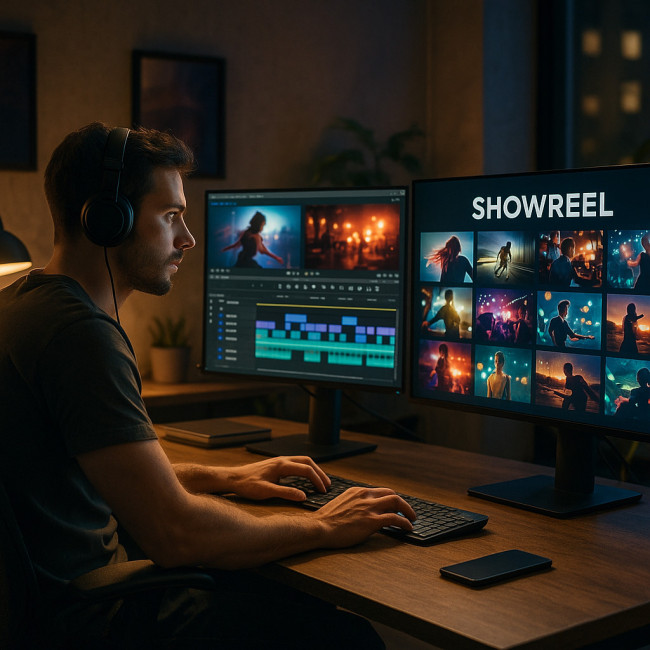Pathways to pro-level skills: how videographers map out continuous learning
Staying ahead in video production means sharpening your creative eye, mastering new software and refining on-set workflows—continuously. This guide shows you how successful videographers design a lifelong learning plan that fits real budgets and busy client calendars.
Why continuous learning powers sustainable careers
The video landscape moves fast: new codecs, AI editors, mixed-reality formats. Adobe's 2024 Creative Skills Forecast notes that 62 % of freelance videographers lost at least one pitch because a competitor offered a newer technique. By mapping an intentional learning route, you:
- Protect your rates against commoditisation.
- Reduce revision cycles by using up-to-date workflows.
- Open doors to premium briefs like interactive or 360° video.
Build your personal skill map in four decisive steps
Step 1 – Run a quick skills matrix audit
List every task you handle, score each from 1 (novice) to 5 (expert), then highlight client demand. A green gap—high demand, low score—marks your next study priority.
| Task | Self-score | Client demand | Priority |
|---|---|---|---|
| Colour grading HDR | 2 | High | Yes |
| FPV drone ops | 3 | Medium | Later |
| Multi-camera live switching | 1 | High | Yes |
Step 2 – Set SMART learning targets
Swap fuzzy goals (“get better at audio”) for specific ones: “Achieve a -14 LUFS mix on first pass for event videos within six weeks.” Measurable wins keep motivation high.
Step 3 – Curate learning channels
Match each priority with the most efficient channel.
- Rapid tweaks? Try micro-learning playlists.
- Industry insight? Join a mentor via a structured mentorship.
- Credibility boost? Compare options in certification paths worth the fee.
The Frame.io 2023 State of Video Report found that 85 % of creators lean on YouTube tutorials weekly, but only 38 % commit to formal certificates—proof that mixing free and paid routes is normal.
Step 4 – Schedule micro-learning sprints & measure progress
Consistency beats marathon courses. Block two 20-minute slots per workday: one before emails, one after renders. Track wins in a simple spreadsheet or the low-cost tools list. When you hit a milestone, deploy it in a paid project within 30 days to lock the skill.
Which channels do videographers choose most?
The survey data mentioned above translates neatly into adoption rates:
Source : Frame.io State of Video Report 2023
Budgeting for growth: free to premium options
Use a tiered approach; invest only when ROI is clear.
| Option | Typical cost | Best for | Example |
|---|---|---|---|
| YouTube playlists | €0 | Quick fixes, gear demos | Five-minute LUT tutorials |
| Online course bundles | €40–€150 | Structured topic deep-dives | DaVinci Resolve colour mastery |
| Live workshops | €250–€600 | Hands-on equipment practice | FPV drone bootcamp |
| Industry certificates | €800–€2 000 | Career credibility, visa points | Adobe Certified Professional |
Turn fresh knowledge into portfolio proof

Clients believe what they can watch. After mastering a skill, integrate it into a personal project—then splice the highlights into a reel. Our footage repurposing roadmap shows how one shoot can spawn five assets, maximising practice time and marketing reach.
For extra exposure, upload case studies to Artfolio's dedicated videographer training hub, where recruiters filter projects by technique mastered.
Self-review loop: keep the cycle alive
- Quarterly re-audit your skills matrix.
- Replace low-ROI channels with higher impact ones.
- Use client feedback as hard data—if revisions drop, the new skill pays off.
Quick quiz: is your learning plan on track?
FAQ
- How much time should a busy freelancer dedicate to learning each week?
- Industry surveys suggest three to five hours keep you competitive without hurting billable work. Spread them across daily micro-sessions.
- Is an expensive certificate always worth it?
- Only if clients in your niche ask for proof of expertise or if it unlocks visa opportunities for international shoots. Otherwise, combine cheaper courses and portfolio evidence.
- What's the fastest way to test a new technique in the field?
- Create a low-stakes personal brief mirroring client constraints—budget, deadline, deliverable—then review results with a mentor before offering it commercially.
Ready to level up? Pick one gap from your matrix, schedule two learning sprints this week and transform the insight into reel-worthy footage within 30 days.











